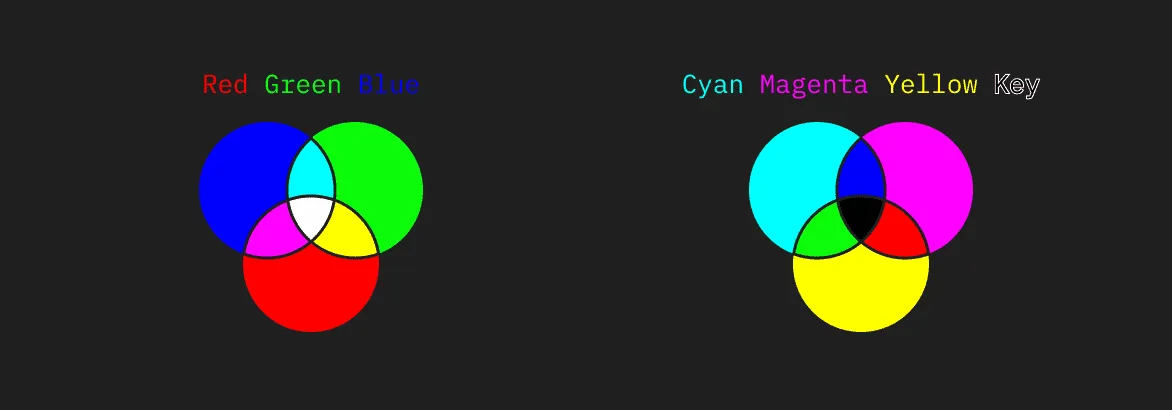Color Theory Models
A reference plus a few applications
ROYGBIV
I first learned the ROYGBIV mnemonic for Red, Orange, Yellow, Green, Blue, Indigo, Violet as an ordered representation of the visible-to-human wavelength spectrum.

RYB (paint)
Primaries: Red, Yellow, Blue
Secondaries (primary + primary mixing): Orange, Green, Purple
Tertiary colors (primary + adjacent secondary mixing): Red-Orange, Yellow-Green, Blue-Violet
Color mixing via paint or pigments makes the mixed color closer to black.
CMYK (print)
CMYK = Cyan, Magenta, Yellow, Black
Yellow + Magenta = Red
Magenta + Cyan = Blue
Cyan + Yellow = Green
Cyan + Magenta + Yellow = Black
Red + Blue + Green = White
Color mixing via light makes the mixed color closer to white.

Halftone printing enables CMYK ink to add additional perceived colors. I sincerely bid you good luck with matching colors from your screen to your fabric swag or colored paper.
HSV, HSL, HSB, HSI
H = Hue
S = Saturation
V = Value
B = Brightness
I = Intensity
There's a lack of consistent standardization and range in colloquial usage of the following terms but they remain widely used across the graphic arts, commercial printing, computer graphics, etc. worlds but:
- Hue or Shade = Color groupings or associations known by name such as Green or Viridian
- Saturation or Chroma = Color intensity or purity
- Light or Brightness or Value = Color across tint, tone, and shade
- Tint = Color + White
- Tone = Color + Gray
- Shade = Color + Black
RGB (light)
RGB or red, green, and blue light-emitting diodes or LEDs create colors on electronic screens.
When decimal or base-10 numbers represent colors, each diode's intensity is represented in 256 levels from 0 (no intensity) - 255 (full intensity) in a series of 3 numbers representing Red, Green and Blue respectively:
- Red = (255, 0, 0)
- Green = (0, 255, 0)
- Blue = (0, 0, 255)
- White = (255, 255, 255)
- Black = (0, 0, 0)
- Gray = (128, 128, 128) - notice that 128 is about half of 255
- White = (255, 255, 255)
255 is the maximum number represented by a byte, which is the 8-bit binary (base-2) number, 11111111.
Hexadecimal
When hexadecimal or base-16 numbers represent colors, each diode's intensity is represented in 2-digit codes ranging from 00 (no intensity) - FF (full intensity) in a series of three codes representing Red, Green, and Blue respectively:
- Red = FF0000
- Green = 00FF00
- Blue = 0000FF
- White = FFFFFF
- Black = 000000
- Gray = 808080
Diodes mix for additional colors:
- Red + Green = Yellow = FFFF00
- Green + Blue = Cyan = 00FFFF
- Red + Blue = Magenta = FF00FF
To count by hexadecimals or convert them from decimal or base-10 numbers, each hexadecimal digit has a value of 0–15 like so:
| Decimal | 0 | 1 | 2 | 3 | 4 | 5 | 6 | 7 | 8 | 9 | 10 | 11 | 12 | 13 | 14 | 15 | 16 | 17 | 18 | 19 | 20 | 21 | 22 | 23 | 24 | 25 | 26 | 27 | 28 | 29 | 30 | 31 |
|---|---|---|---|---|---|---|---|---|---|---|---|---|---|---|---|---|---|---|---|---|---|---|---|---|---|---|---|---|---|---|---|---|
| Hexadecimal | 0 | 1 | 2 | 3 | 4 | 5 | 6 | 7 | 8 | 9 | A | B | C | D | E | F | 10 | 11 | 12 | 13 | 14 | 15 | 16 | 17 | 18 | 19 | 1A | 1B | 1C | 1D | 1E | 1F |
| Decimal | Hexadecimal | Digits |
|---|---|---|
| 0-9 | 00-09 | 10 |
| 10-15 | 0A-0F | 6 |
| 16-25 | 10-19 | 10 |
| 32-41 | 20-29 | 10 |
| 42-47 | 2A-2F | 6 |
| 48-57 | 30-39 | 10 |
| ... | ... | ... |
| 154-159 | 9A-9F | 6 |
| 160-169 | A0-A9 | 10 |
| 170-175 | AA-AF | 6 |
| 176-191 | B0-BF | 10 |
| ... | ... | ... |
| 240-249 | F0-F9 | 10 |
| 250-255 | FA-FF | 6 |
Example Applications
Throw most of what was written out the door.
Skin Colorism and Beyond
When Homer envisioned Achilles, did he see a Black man?
Hair Coloring x Aesthetics Industry Marketing
Coloring hair requires knowing your base color and condition as well as the target color.
For example, starting with undamaged pale blonde hair removes the need for bleaching.
Red, orange, auburn, or brown hair dying falls within its own spectrum when colors are added. Results may significantly vary.
Natural dark hair colors can skip bleaching but require color-depositing masks and continued maintenance for color sustenance.
Aiming to achieve pastel colors with dark brown or black hair requires multiple bleaching, dying, toning, and conditioning sessions not to mention additional waiting times in between to attain highly saturated or pastel colors while minimizing hair or scalp damage.
Bleach is also called developer, which breaks down natural melanin pigments, also known as lifting hair through numbered levels from black (1) to pale yellow or the lightest blonde (10). After bleaching, using toner, which contains purple or blue pigments, neutralizes brassy yellow warm tones in bleached dark hair towards the light blonde canvas that allows for directly translated colors to the tresses.
Don't even get me started on textures.
If you want to play it safe, hair strand tests and patience are your best friends. Alternatively, go to an experienced professional.